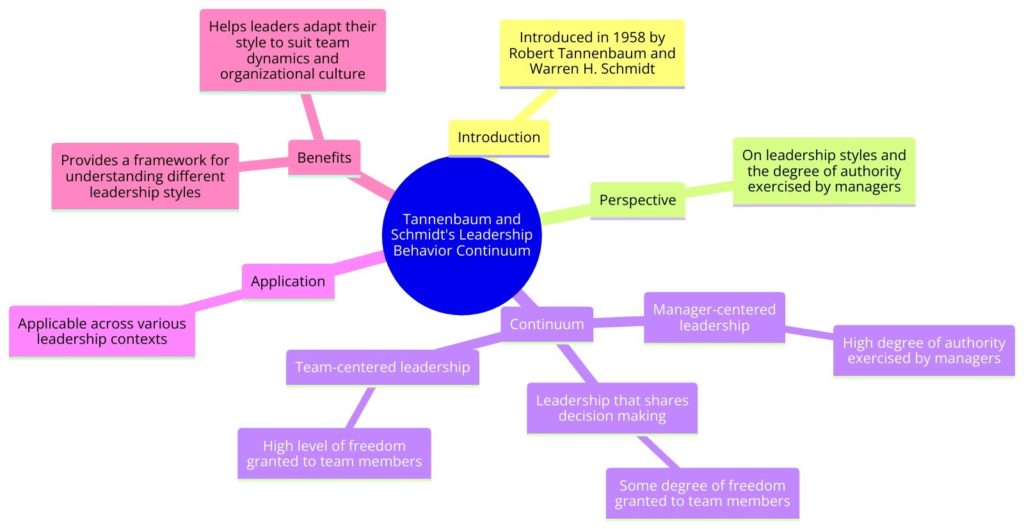Leadership Behavior Continuum Model
Tannenbaum and Schmidt’s Leadership Behavior Continuum Model, introduced in 1958 by Robert Tannenbaum and Warren H. Schmidt, offers a pioneering perspective on leadership styles and the degree of authority exercised by managers versus the level of freedom granted to team members. This model is distinguished by its focus on the dynamic nature of leadership and the situational factors that influence leadership behavior. It underscores the importance of flexibility in leadership, advocating that effective leaders adjust their approach based on the specific needs of the situation, the task at hand, and the team’s characteristics.
What is Tannenbaum & Schmidt’s Leadership Behavior Continuum Model?
The Leadership Behavior Continuum Model presents a range of leadership styles on a spectrum, from authoritarian (leader-centered) to democratic (follower-centered). The model suggests seven distinct points along the continuum where leadership behavior might reside:
- Tells (Authoritarian): The leader makes decisions unilaterally and expects followers to comply.
- Sells: The leader still makes the decision but attempts to persuade followers of its merits.
- Suggests: The leader presents ideas and invites questions.
- Consults: The leader presents tentative decisions subject to change and invites input from followers.
- Joins: The leader shares decision-making responsibilities with followers, seeking consensus.
- Delegates: The leader sets the limits but allows followers to decide within those limits.
- Abdicates (Democratic): The leader allows full freedom within defined boundaries.
Why It Is Valuable
Tannenbaum and Schmidt’s model is invaluable for several reasons:
- Flexibility in Leadership: It highlights the need for leaders to be adaptable, changing their style based on the situation and the development level of their team members.
- Empowerment and Motivation: By acknowledging the value of more democratic leadership styles, the model underscores how empowering team members can enhance motivation and satisfaction.
- Enhanced Decision-Making: The model suggests that involving team members in the decision-making process can lead to better outcomes through a richer pool of ideas and increased buy-in.
- Situational Awareness: It encourages leaders to develop their situational awareness, improving their ability to assess when to exert control and when to grant autonomy.
When and How to Use It
The Leadership Behavior Continuum can be applied across various organizational contexts, from daily team management to strategic decision-making. Leaders can use this model to:
- Reflect on their default leadership style and its effectiveness.
- Assess team members’ readiness, task complexity, and the organizational environment to determine the most appropriate leadership style.
- Gradually adjust their leadership approach as team members develop and situations evolve.
- Communicate with team members about leadership style choices to set clear expectations and foster understanding.
Shortcomings/Criticisms
While Tannenbaum and Schmidt’s model has been influential, it is not without its critiques:
- Lack of Specific Guidance: The model provides a broad framework without detailed guidance on precisely how to assess situations or implement specific leadership styles.
- Overemphasis on Leader Flexibility: Critics argue that it may overburden leaders with the responsibility to adapt without adequately considering the influence of organizational culture or the inherent traits of followers.
- Situational Complexity: Real-world situations may be more complex than the continuum suggests, requiring a blend of leadership styles rather than a single point along the continuum.
- Empirical Support: There is limited empirical research directly supporting the model, with some studies suggesting leadership effectiveness may also depend on factors not accounted for in the continuum.
In conclusion, Tannenbaum and Schmidt’s Leadership Behavior Continuum Model offers a valuable framework for understanding the range of leadership styles available to managers and the importance of adapting those styles to the context and needs of the team. By promoting flexibility and situational awareness, the model encourages leaders to be more thoughtful and responsive in their approach to leadership. Despite its limitations, the model remains a useful tool for leaders seeking to enhance their effectiveness in managing diverse teams and complex organizational dynamics.


